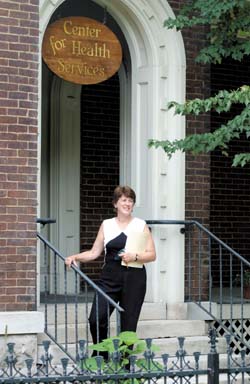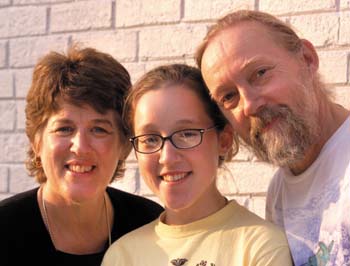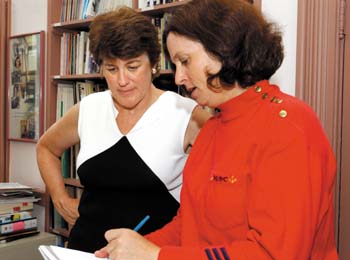
Barbara Clinton is the director of the Center for Health Services at Vanderbilt, which organizes programs for the improvement of public health and community empowerment projects. She has been the director for 14 years. (photo by Dana Johnson)
Community-builder: Barbara Clinton spends time, energy helping others


From left, Barbara Clinton, her daughter Catie Clinton-Selin, and her husband Jim Selin. (photo by Dana Johnson)

Clinton and budget administrator Jill Flowers work together to solve a problem. (photo by Dana Johnson)
In a small, historic house next to Medical Center North, away from the daily bustling of the Vanderbilt University Medical Center, Barbara Clinton works in her office, surrounded by mismatched furniture. It is obvious from the simple setting that this is not the place where the heart of Clinton’s work occurs. “We don’t really spend money on furniture here,” she says as she takes a seat.
Sure, this old house may be where Clinton spends time making contact with government agencies and foundations, but those efforts are simply channels to larger goals. Barbara Clinton is the director of the Center for Health Services (CHS), and the money that she raises goes toward the improvement of public health and community empowerment projects. It goes toward an increase of prenatal care in rural areas, better drinking water, and assistance to the elderly, to name a few.
“The CHS mission is to support community health efforts that are within the control of community people,” Clinton said. “Our work is to link disadvantaged community groups to the wealth and resources of this university. First among these resources is the energy and idealism of students and faculty.”
The life of the CHS began 12 years before Clinton’s arrival, with the creation of the Appalachian Student Health Coalition (SHC) in 1968 by a group of Vanderbilt and Meharry students. Their mission was to help local citizens who did not have access to health care gain access. In an effort to reach this goal, these students began organizing and implementing public health outreach projects.
Eventually, the SHC needed a superstructure to organize and manage their different programs and volunteers, to raise money, and to conduct research. From this necessity, the Center for Health Services was born in 1969.
“The Center was essentially an instrument for channeling student activism through the bureaucracy of the University and the supporting foundations, and its governance was heavily weighted toward the dominance of students’ initiatives,” Dr. Lewis B. Lefkowitz, Jr., professor of Preventive Medicine, Emeritus, and a longtime supporter of the Center, said.
Now, the CHS serves as the umbrella organization for several different programs, many of which still rely a great deal on the input and effort of students. Over the years, the CHS has been involved with more than 40 different public health and community service projects, ranging from environmental initiatives to farm aid programs.
“The CHS is governed by an advisory board of extraordinary students, faculty, and community people,” Clinton said. “Together they guide a set of programs that have achieved national and international recognition because of their consistent ability to support community health.”
For Clinton and the staff of the Center, it is in these projects that the real work of the CHS lies, not in the inconspicuous, redbrick house in the middle of the Vanderbilt campus. It is in the Maternal Infant Outreach Worker Project (MIHOW) sites throughout the Southeast and in the health fairs, still being run by the Student Health Coalition.
The Center offered Clinton a chance to further develop her interest in public health and community activism that had been a part of her life as a child and a young adult. “When I was recruited to the Center for Health Services at Vanderbilt, it was a perfect fit for me,” Clinton said.
Even in her youth, Clinton was surrounded by activists. She was born into a large, Irish-Catholic family in New York City. Her mother and father served their community as a teacher and a police lieutenant respectively, but it is in the stories about her grandfather that Clinton sees a foreshadowing of her own life’s work.
“My grandfather was a sea captain who was something of an Irish revolutionary before the independence from England,” Clinton said. “So I like to think that there is a little of him in me.”
Clinton also identifies her Catholic upbringing, in which service to others played a large part, as a strong influence on her decision to work in community outreach.
After college, Clinton became a counselor in a residential treatment facility for children, and later at the Children’s Hospital in Buffalo, NY, where her interest in public health was sparked. She had several additional jobs in social work and counseling before returning to school.
Clinton’s career in community organizing formally began when she attended graduate school to study social work at the University of Georgia.
“Although I don’t do traditional social work, I am really glad that I have that training because it is one of the fields that focuses on the have-nots and recognizes that there are cultural and economic forces that put people in difficult positions that can be addressed through community action,” Clinton said.
Even without an elaborate space or a loud presence on campus, Clinton and the Center are a huge success. Under her leadership since 1987, the CHS has received numerous awards, the most recent of which is the Oscar van Leer Award, which will be presented to the Center in recognition of the MIHOW program “for excellence in enabling parents and communities to help young children realize their innate potential.” The award is given every two years by the Bernard van Leer Foundation, a Dutch foundation that supports programs around the globe designed to help the development of children ages zero to eight. This is the first time that the award has been presented to an American program. It includes a grant of $10,000.
As the first director of the MIHOW project, Clinton deserves much of the credit for the achievements of this program. Its focus on involving local people in the health and prenatal care of mothers and babies in rural areas and inner cities illustrates the kind of relationship between the Center and communities that Clinton has pushed for as director of the CHS.
Clinton and the Center have also been awarded grants from numerous prestigious organizations, such as the Robert Wood Johnson Foundation, and have received attention from the government. Clinton was asked by former Vice President Al Gore to sit on the Father to Father White House advisory board in 1996 in addition to serving for many years as one of the former vice president’s advisors on Appalachia and rural areas.
“Barbara’s assumption of the directorship of the Center began an era of recognition and prominence of the Center,” Lefkowitz said. “She has gained the respect of her peers for her deep understanding of communities and her advocacy for public interest.”
While many people strive to separate their persona at work from their life at home, Clinton’s commitment to community service and empowerment work does not disappear in her daily transition from VUMC faculty member to family member. Clinton appears to be guided by the same principles 24 hours a day. Convictions such as respect for the community and a positive perception of human nature are the foundation for her actions with both the Center and with her family.
Because of this, according to Lefkowitz, Clinton is a full-time advocate. “Her agenda is the community’s agenda,” he said.
Her activism extends outside Vanderbilt’s campus to her own neighborhood. Clinton has chosen to make her home with her husband and two daughters in Nashville’s Woodbine neighborhood, a hotbed of community involvement and leadership. She is active in the Woodbine Community Organization and on the board of the Woodbine Community Credit Union, a new effort that has been established to help low-income people, immigrants, and refugees get involved with the banking system. The credit union was created to provide an alternative to the pay-day check, pay-day loan operations that charge patrons high interest rates, Clinton said.
Clinton’s home and work life have converged in other ways as well. The MIHOW program began in 1982 when Clinton was pregnant with her first child.
“It was perfect for me because I was definitely interested in pregnancy at the time,” Clinton said. “As my children were all born, they came through the MIHOW program with me: pregnancy, birth, breastfeeding, early child development. They sort of grew up with it.”
Another aspect of the MIHOW program that has special significance for Clinton’s family is the distribution of small grants to local community programs that use the money to engage fathers more effectively in the lives of their children. According to Clinton, this program touches her personally because her own husband, an environmentalist and community activist, is very active in the lives of their children; he home-schooled the two girls while they were in elementary and middle school.
“I really like the idea of reaching out to the fathers who are magnificent and underappreciated and not honored enough, and they need to be honored,” Clinton said.
After speaking with Clinton for a while, it becomes clear that talking about herself is not something she does often. Almost automatically, the conversation drifts to the subject of others: her co-workers, the students involved at the Center, the community leaders she has met, her family.
The support and attention that Clinton gives to those around her is based upon the same idea that drives the work of the Center: the belief that people are capable of almost anything, if they only have the right tools.
In her eyes, gone are the antiquated notions of paternalism, philanthropy, and charity. In their place are the principles of empowerment, encouragement, and action.
“All over the world there are good, hard-working sensitive people, some with very minimal resources, some with major resources, who have found ways to make their communities better,” Clinton said. “And I wish that there were more ways to attract and make it possible for young people to meet that kind of person so that they can see what’s possible. That’s really the way you get to be happy, by doing that kind of work.”













